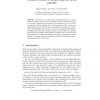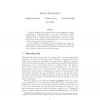136
Voted
LICS
2012
IEEE
13 years 3 months ago
2012
IEEE
—This paper introduces HOpiPn, the higher-order pi-calculus with passivation and name creation, and develops an equivalence theory for this calculus. Passivation [Schmitt and Ste...
140
Voted
CSFW
2012
IEEE
13 years 3 months ago
2012
IEEE
—Social sign-on and social sharing are becoming an ever more popular feature of web applications. This success is largely due to the APIs and support offered by prominent social ...
133
click to vote
CCS
2011
ACM
14 years 17 days ago
2011
ACM
We consider security properties of cryptographic protocols that can be modeled using the notion of trace equivalence. The notion of equivalence is crucial when specifying privacy-...
150
Voted
FORTE
2009
14 years 10 months ago
2009
We propose an epistemic logic for the applied pi calculus, which is a variant of the pi calculus with extensions for modeling cryptographic protocols. In such a calculus, the secur...
107
Voted
CONCUR
2010
Springer
15 years 1 months ago
2010
Springer
Abstract. We present a reconstruction of session types in a conventional pi calculus where types are qualified as linear or unrestricted. Linearly typed communication channels are ...
109
Voted
FOSAD
2000
Springer
15 years 4 months ago
2000
Springer
Abstract. There is great interest in applying nominal calculi--computational formalisms that include dynamic name generation--to the problems of programming, specifying, and verify...
100
click to vote
CONCUR
2003
Springer
15 years 5 months ago
2003
Springer
A linear forwarder is a process which receives one message on a channel and sends it on a different channel. Such a process allows for a simple implementation of the asynchronous...
110
click to vote
FOSSACS
2004
Springer
15 years 6 months ago
2004
Springer
The pi calculus holds the promise of compile-time checks for whether a given program will have the correct interactive behaviour. The theory behind such checks is called bisimulati...
141
Voted
CIS
2004
Springer
15 years 6 months ago
2004
Springer
The pi calculus has been applied to modelling biochemical networks. In these applications, the modelling is done without considerations to exceptions. The Ipi calculus, the Interfe...
234
Voted
POPL
2001
ACM
16 years 27 days ago
2001
ACM
We study the interaction of the "new" construct with a rich but common form of (first-order) communication. This interaction is crucial in security protocols, which are ...




